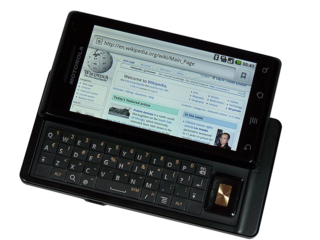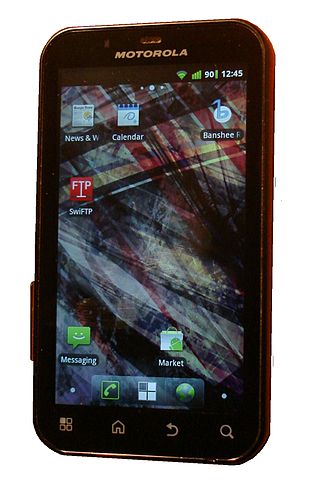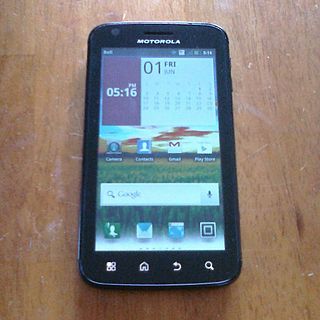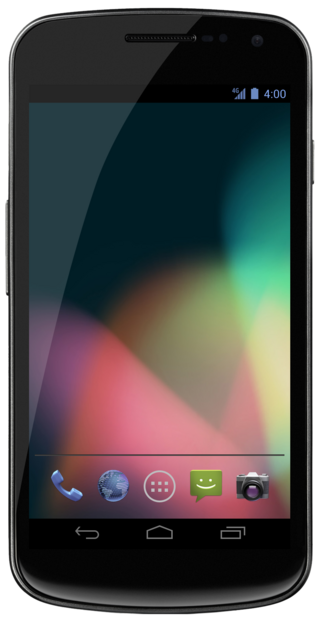A milestone is a marker of distance along roads.
Contents
- Measurements
- Geography
- Literature
- Film and TV
- Music
- Bands
- Albums
- Songs
- Brands and enterprises
- People with the surname
Milestone may also refer to:
A milestone is a marker of distance along roads.
Milestone may also refer to:
Titan most often refers to:

Kai Chresten Winding was a Danish-born American trombonist and jazz composer. He is known for his collaborations with fellow trombonist J. J. Johnson. His version of "More", the theme from the movie Mondo Cane, reached in 1963 number 8 in the Billboard Hot 100 and remained his only entry here.
The Motorola Razr2 (often stylized as RAZR2) is a series of clamshell/flip mobile phones from Motorola, and is one of the series in the 4LTR line. It is the successor to the popular Razr series. The Razr2 is 2 mm thinner than its predecessor but slightly wider. Some versions feature Motorola's MotoMagx operational platform, based on the MontaVista Linux OS. The Razr2 was made available on every US carrier, and EVDO, GSM and HSDPA versions of it were released by late 2007.
Dave Schildkraut was an American jazz alto saxophonist.

The Motorola Droid is an Internet and multimedia-enabled smartphone designed by Motorola, which runs Google's Android operating system. The Droid had been publicized under the codenames Sholes and Tao and the model number A855. In Latin America and Europe, the model number is A853 (Milestone), and in Mexico, the model number is A854 (Motoroi). Due to the ambiguity with newer phones with similar names, it is also commonly known as the DROID 1. The brand name Droid is a trademark of Lucasfilm licensed to Verizon Wireless.

The Sony Ericsson Xperia X10 is a 2010 high end smartphone in the Xperia series designed by Sony Ericsson. It was the first Sony Ericsson smartphone to run the Android operating system. The phone was shipped with Android 1.6 (Donut), but an upgrade to 2.1 (Eclair) was made available starting 31 October 2010, with a gradual international rollout. Originally, Sony Ericsson stated that the X10 would not receive an upgrade to Android 2.2 (Froyo) or beyond, but the phone was later upgraded to 2.3.3 (Gingerbread) with the updates starting on 29 July 2011.
Devour may refer to:

The Motorola Defy (A8210/MB525) is an Android-based smartphone from Motorola. It filled a niche market segment, by being one of the few small, IP67 rated smartphones available at the time of its late 2010 release; it is water resistant, dust resistant, and has an impact-resistant screen. An updated version of the original model, Defy+ (MB526) was released in 2011. Other variants were also released before a revival of the Defy name in 2021.

The Nexus S 4G is a smartphone co-developed by Google and Samsung and manufactured by Samsung Electronics for release in 2010. It was the first smartphone to use the Android 2.3 "Gingerbread" operating system, and the first Android device to support Near Field Communication (NFC) in both hardware and software.

The Motorola Atrix 4G is an Android-based smartphone developed by Motorola, introduced at CES 2011 along with the Motorola Xoom, Motorola Droid Bionic, and Motorola Cliq 2 on January 5, 2011. It was made available in the first quarter of 2011.

The Samsung Infuse 4G was an Android smartphone that was released by Samsung in May 2011. It has a 1.2 GHz Hummingbird processor with 8–16 GB internal Flash memory, a 4.5 inch 480×800 pixel Super AMOLED Plus capacitive touchscreen display, an 8-megapixel camera and a 1.3-megapixel front-facing camera.

The Motorola Milestone XT720 is an Android-based smartphone manufactured by Motorola Mobility, originally released in July 2010. Announced in June of that year, it was the first Motorola Android phone with xenon flash.

The Motorola DROID 3 is a smartphone released on July 7, 2011, by Verizon Wireless running the Android 2.3 operating system by Google. It comes with 16 GB of internal storage. The smartphone does not ship with a microSD card. It has a 4-inch qHD display and an 8-megapixel camera capable of recording 1080p video. Unlike the DROID 2, the Motorola DROID 3 features a 5-row QWERTY keyboard, with a dedicated number row. It also has a VGA front-facing camera for video calls. The Droid 3 ships with Android 2.3.4 (Gingerbread) with Motorola's updated proprietary Motoblur UI. Like other contemporary Motorola phones, it has a locked bootloader, but it can have a custom rom using SafeStrap.

The Galaxy Nexus (GT-I9250) is a touchscreen Android smartphone co-developed by Google and Samsung Electronics. It is the third smartphone in the Google Nexus series, a family of Android consumer devices built by an original equipment manufacturer partner. The phone is the successor to Google's previous flagship phones, the Nexus One and Nexus S.

The Verizon Droid Razr is an Android-based, 4G LTE-capable smartphone designed by Motorola that launched on Verizon Wireless on November 11, 2011. It was announced on October 18, 2011 in New York City.

AOKP, short for Android Open Kang Project, is an open-source replacement distribution for smartphones and tablet computers based on the Android mobile operating system. The name is a play on the word kang and AOSP. The name was a joke, but it stuck. It was started as free and open-source software by Roman Birg based on the official releases of Android Open Source Project by Google, with added original and third-party code, features, and control.

The Moto G is an Android smartphone developed and manufactured by Motorola Mobility, at the time a subsidiary of Google. Released on 13 November 2013, the phone was initially aimed at emerging markets, although it was also available in developed markets as a low-price option.

The Moto X Style is the flagship third-generation of Moto X Android smartphone developed and manufactured by Motorola that was released on September 2, 2015.

Moto X Play is an Android smartphone developed by Motorola Mobility, a subsidiary of Lenovo. Unveiled on July 28, 2015, it was one of three devices that succeeded the second-generation Moto X. In contrast to the high-end Moto X Style, the Play is a mid-range device distinguished by its high battery capacity.

Bootloader unlocking is the process of disabling the bootloader security that makes secure boot possible. It can make advanced customizations possible, such as installing a custom firmware. On smartphones this can be a custom Android distribution or another mobile operating system. Some bootloaders are not locked at all, others can be unlocked using a standard command, others need assistance from the manufacturer. Some do not include an unlocking method and can only be unlocked through a software exploit.